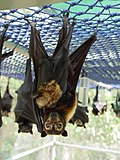| Spectacled flying fox | |
|---|---|
 | |
| Male, female, and their young | |
| Scientific classification | |
| Kingdom: | Animalia |
| Phylum: | Chordata |
| Class: | Mammalia |
| Order: | Chiroptera |
| Family: | Pteropodidae |
| Genus: | Pteropus |
| Species: | P. conspicillatus |
| Binomial name | |
| Pteropus conspicillatus Gould, 1850 | |
 | |
| Distribution of the spectacled flying fox | |
The spectacled flying fox (Pteropus conspicillatus), also known as the spectacled fruit bat, is a megabat that lives in Australia's north-eastern regions of Queensland. It is also found in New Guinea and on the offshore islands including Woodlark Island, Alcester Island, Kiriwina, and Halmahera.
Contents
- Description
- Habitat
- Diet
- Life cycle
- Life expectancy
- Conservancy
- Gallery
- References
- Further reading
- External links
The spectacled flying fox was listed as a threatened species under the Environment Protection and Biodiversity Conservation Act 1999. They were considered vulnerable due to a significant decline in numbers as a result of loss of their prime feeding habitat and secluded camp sites. It has also been reported that spectacled flying foxes skim over the surface of water to drink and are sometimes eaten by crocodiles. [3] The species was classified as endangered by the IUCN in 2020. [1]
In February 2019, the Australian government upgraded the threatened status from vulnerable to endangered, after almost a third of the bat population died in a severe heatwave in Queensland in late 2018. [4]








